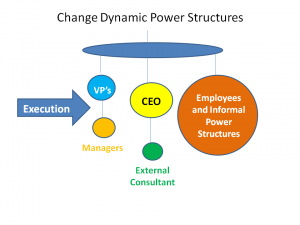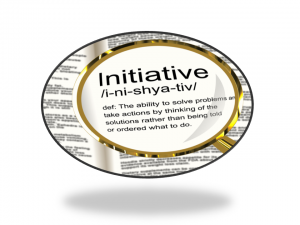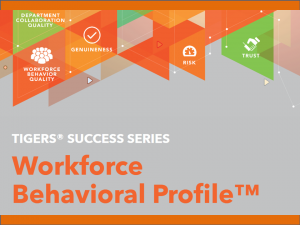 Many people resist change execution. For some, change is scary because they lose control. For others, the desire to appear competent is a driver. Change and learning new things takes everyone back to zero.
Many people resist change execution. For some, change is scary because they lose control. For others, the desire to appear competent is a driver. Change and learning new things takes everyone back to zero.
Remember what it was like to change computer programs or learn a complex new system? You have probably seen firsthand how resistant people can be when change execution is thrust is upon them. New things need to be learned. Once learned, new habits form. The gap between what is now and what must happen in the future is sometimes uncomfortable. This is especially true when feeling incompetent is coupled with competing to maintain a favorable position in the pecking order. No one likes to feel like the slow person in class.
Change, however, is a necessary part of life. The workplace is no different. Even if employees resist change execution, strong leaders must drive it. In order to remain competitive, leaders who are open and adaptable to change bring flexibility and reassurance when needed most.
Effective leaders also understand that change brings about innovation. It, therefore, makes sense that an change execution strategy is needed.
TIGERS® Strategies for Change Execution Initiatives
 One strategy for implementing smooth change is to get team members on board prior to change execution initiatives. To do this, leaders who engage their employees first have the upper hand. These are leaders who are competent in facilitating the free flow of employee ideas, problem solving and planning. This is the type of planning that executes smoothly because employees are behind it.
One strategy for implementing smooth change is to get team members on board prior to change execution initiatives. To do this, leaders who engage their employees first have the upper hand. These are leaders who are competent in facilitating the free flow of employee ideas, problem solving and planning. This is the type of planning that executes smoothly because employees are behind it.
For example, in the picture we are showing, the size of the circle is the size of change execution influence. The largest circle is employees. This circle also includes supervisors. Even through the CEO is the person in charge, change is resisted unless the largest circle (employees) are onboard.
Start with champions to launch change execution.
While it’s important to take a top-down approach when measuring and benchmarking change initiatives, leaders can only drive change to a certain point notes Engage Your Employees to Champion Change. Your leaders are typically on the ground floor of change initiatives. For example, they know about it in advance. Then what?
Leaders understand the gap change presents between now and the future only to a certain point. Perhaps that understanding is from an isolated perspective. For example, in a system such as a work flow process, a change in one area can bring unforeseen consequences to another area. If the change crosses silos, the risk of encountering unknown complications increases. Therefore, it is important to understand the ins and outs from the employee perspective before the initiative is presented to the rest of the team or organization.
This is where your champions come in. Your champions are engaged employees you identify who will help you reason through the impact of change. They can point out problems so you can reduce risk. By gaining their trust and listening and acting on their realistic concerns, your champions will help drive change by reducing resistance to change with their colleagues and peers.
When implementing change execution how many champions are required?
 A good rule of thumb is to have around 20 percent of your supervisors and informal leaders already on board before change rolls out. These champions create momentum. They model desired skills and behavior before the remaining workforce adopts it.
A good rule of thumb is to have around 20 percent of your supervisors and informal leaders already on board before change rolls out. These champions create momentum. They model desired skills and behavior before the remaining workforce adopts it.
Before the change takes place, focus on training your 20 percent extremely well to create consistent role models for the behavior and skill dynamics you desire. Then, as the remaining team members are trained, they experience the desired performance in action. This breaks down resistance to change.
To create a strong 20 percent, bring in a mix of employees. Consider employees who are open to change, managers, informal leaders and other connectors such as a member of your marketing and internal communications staff. Show them the rewards. Have them help you build your change safety net. These employees are your ambassadors. They will generate excitement for the end result.
During change execution, recognize a job well done.
Recognition has a powerful influence on achievement. When you want to get your 20% on board, recognize even small steps in the right direction. Then carry through with the rest of your workforce.
Recognizing teams who do well during change execution shows others how to be successful, too. Then sharing lessons learned and mistakes made continues the learning process. It also takes shame and defeat out of the learning process.
How work culture impacts change execution.
Your company’s culture plays a key role in how team members react to a change initiative. If your performance management practices do not support the change execution process, your employees and customers will identify inconsistencies.
For example, if one of your company’s values is collaboration, collaboration reinforcement is required for change execution. If employees are only recognized on an individual basis, team members learn that individual performance is more important than the team’s cooperation.
In order to align values with practice, measure and reward behaviors and skills you value. Then create a consistent reward system. This is critical during change execution.
Know your culture behavior strengths before change execution.
 It is difficult to design a successful change execution plan when you don’t know your culture behavior strengths and weaknesses. For example, when driving change in a department with a low trust performance profile, change takes longer and is often resisted to the point of failure.
It is difficult to design a successful change execution plan when you don’t know your culture behavior strengths and weaknesses. For example, when driving change in a department with a low trust performance profile, change takes longer and is often resisted to the point of failure.
This is where a team behavior culture assessment proves invaluable for the change execution pre-launch stage. The TIGERS Workforce Behavioral Profile™ is a simple, web-based assessment designed to help you monitor your workforce behavior before you gather your champions. It measures the quality of six principles required for high performance and resilient work groups.
The six principles are trust, interdependence, genuineness, empathy, risk and success. They are anchored by behaviors that produce work group resilience. When less developed or weak, they predict problems that will emotionally impair change execution and magnify resistance.
For example, if problems with trust exist and it is known before your champions gather, they will help you identify real world and work specific ways to enhance trust throughout the change execution process. The assessment also predicts if department leaders would benefit from executive coaching throughout the change initiative. This assessment helps you identify your support avenues.
This researched-based, team assessment alerts you early before performance issues and employee resistance disrupt your change execution goals. By being proactive in this area, you can address issues early on before issues and change resistance surface.
Micro-train before change execution.
One of the best ways to improve behavior skill improvement in the workplace is through micro-training. This is training that consistently reinforces skills, attitudes and practice over a substantial period of time but takes under 30 minutes to learn. TIGERS micro-training meets this standard and is available to every employee.
One-off trainings and full-day classroom events, on the other hand, produce learning retention of around ten percent. The rule of thumb is that people retain approximately 10 percent of what they see; 30 to 40 percent of what we see and hear; and 90 percent of what we see, hear, and do.
Therefore, TIGERS® micro-training designed to help companies improve group dynamic behavior when change execution is based on the following training criteria:
- TIGERS® deploys spaced repetition training. For example, all employees receive weekly training information broken down into twelve months that consistently reinforces effective trust behavior and trust building skills if trust measured low when taking the TIGERS Workforce Behavior Profile™. We know, if you want employees to remember something, they must be exposed to it in different ways and through different methods over time.
- Training is interactive. TIGERS® helps you Quiz yourself on what is learned and awards points when a training segment completed. Then leaders can use what is learned to advance change or work initiatives.
- TIGERS micro-training also allows employees to take notes long-hand. Perhaps one idea from five ideas presented in training resonates with one employees and two or more ideas resonate with others. TIGERS micro-training allows employees to use what is most beneficial to them in their work and in the moment. Then due to the interactive advantage, three months down the road an employee can revisit a training and add something new to their behavior skill improvement because repeated access to the training room is available for an entire year.
- Explain your knowledge to someone else. Due to the nature of TIGERS interactive micro-training, employees are encouraged to explain what they have learned with co-workers or their managers. They can also practice new skills with friends and family before launching their new skill into the workplace. Practice makes perfect. The customized way TIGERS micro-training is designed, builds both community improvement and skill enhancement.
- Take breaks when studying. There is a saying that the best way to eat an elephant is one bite at a time. 52-weeks of training and gentle reinforcement produce results through practice and gradual behavior change. All of this is measurable through the TIGERS Workforce Behavioral Profile with the micro-training process.
Change execution summary
Change is inevitable. At work, remaining competitive in an ever-changing, customer-driven environment requires strategy and practice. This includes getting employees on board before change execution.
TIGERS change execution strategies include:
- Start with your champions. Reason through change initiatives before the change is introduced to the rest of the team. Then train your champions. This results in less resistance and faster implementation.
- Recognizing a job well done.
- Know your organization’s behavior strengths and weaknesses. Assessments like the TIGERS Workforce Behavioral Profile™ give leaders strategic information during the planning stage. It reduces unexpected behavior risks during change implementation and shows you which of your department managers to support.
- Shore up weaknesses with micro-training and tie learning to real work initiatives.
Change is typically resisted. By engaging employees first, leaders get team members on board. Enthusiastic and engaged employees then drive change success.
Care to dig deeper into this change execution conversation?
The following resources are recommended:
- Engage Your Employees to Champion Change
- When Mission Doesn’t Matter
- TIGERS Workforce Behavioral Profile
- Download a sample TIGERS Workforce Behavioral Profile report
- TIGERS® leader as facilitator training
Copyright TIGERS Success Series, Inc. by Dianne Crampton
About TIGERS Success Series Group Norm Facilitator Training
 TIGERS Success Series provides a Manager Facilitator training with a tool box that engages employees to identify the group norms that improve both department and company work culture. It helps organizations to re-engage employees, resolve conflict behavior and builds work relationships. These same resources and tool box can be used to onboard new employees and contractors onto existing teams so behavior is understood and normalized from the get-go. The training and tool box are brought to you when eight or more of your managers are enrolled.
TIGERS Success Series provides a Manager Facilitator training with a tool box that engages employees to identify the group norms that improve both department and company work culture. It helps organizations to re-engage employees, resolve conflict behavior and builds work relationships. These same resources and tool box can be used to onboard new employees and contractors onto existing teams so behavior is understood and normalized from the get-go. The training and tool box are brought to you when eight or more of your managers are enrolled.